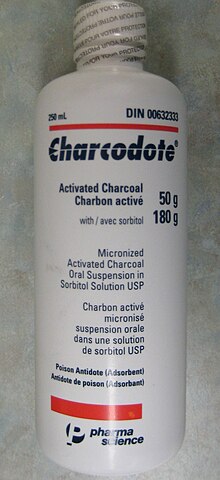 Activated charcoal for medical use | |
| Clinical data | |
|---|---|
| Trade names | CharcoAid, others |
| AHFS/Drugs.com | Monograph |
| Routes of administration | By mouth, nasogastric tube |
Activated charcoal, also known as activated carbon, is a medication used to treat poisonings that occurred by mouth.[2] To be effective it must be used within a short time of the poisoning occurring, typically an hour.[2][4] It does not work for poisonings by cyanide, corrosive agents, iron, lithium, alcohols, or malathion.[4] It may be taken by mouth or given by a nasogastric tube.[5] Other uses include inside hemoperfusion machines.[2]
Common side effects include vomiting, black stools, diarrhea, and constipation.[2] The more serious side effect, pneumonitis, may result if aspirated into the lungs.[2][4] Gastrointestinal obstruction and ileus are less common but serious adverse effects.[2] Use in pregnancy and breastfeeding is safe.[5] Activated charcoal works by adsorbing the toxin.[2]
While charcoal has been used since ancient times for poisonings, activated charcoal has been used since the 1900s.[6][7] It is on the World Health Organization's List of Essential Medicines.[8] The wholesale costs in the developing world is between US$0.46 and US$0.86 per dose.[9] In the United States a course of treatment costs less than US$25.[5] In the UK, a single dose costs around £12.[10]
References
edit- ^ a b Cite error: The named reference
MSF2020was invoked but never defined (see the help page). - ^ a b c d e f g h "Charcoal, Activated". The American Society of Health-System Pharmacists. Archived from the original on 21 December 2016. Retrieved 8 December 2016.
- ^ Cite error: The named reference
whowas invoked but never defined (see the help page). - ^ a b c World Health Organization (2009). Stuart MC, Kouimtzi M, Hill SR (eds.). WHO Model Formulary 2008. World Health Organization. p. 57. hdl:10665/44053. ISBN 9789241547659.
- ^ a b c Hamilton, Richart (2015). Tarascon Pocket Pharmacopoeia 2015 Deluxe Lab-Coat Edition. Jones & Bartlett Learning. p. 469. ISBN 9781284057560.
- ^ Cecen, Ferhan; Aktas, Özgür (2011-09-19). "1". Activated Carbon for Water and Wastewater Treatment: Integration of Adsorption and Biological Treatment. John Wiley & Sons. ISBN 9783527639458. Archived from the original on 2016-12-20.
- ^ Tascón, J. M. D. (2012). Novel Carbon Adsorbents. Elsevier. p. 640. ISBN 9780080977447. Archived from the original on 2016-12-20.
- ^ World Health Organization (2019). World Health Organization model list of essential medicines: 21st list 2019. Geneva: World Health Organization. hdl:10665/325771. WHO/MVP/EMP/IAU/2019.06. License: CC BY-NC-SA 3.0 IGO.
- ^ "Charcoal, Activated". International Drug Price Indicator Guide. Archived from the original on 22 January 2018. Retrieved 13 August 2015.
- ^ Hitchings, Andrew; Lonsdale, Dagan; Burrage, Daniel; Baker, Emma (2019). The Top 100 Drugs: Clinical Pharmacology and Practical Prescribing (2nd ed.). Elsevier. pp. 32–33. ISBN 978-0-7020-7442-4. Archived from the original on 2021-05-22. Retrieved 2021-11-09.